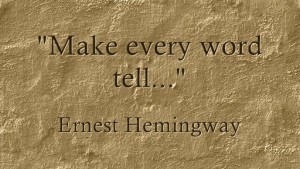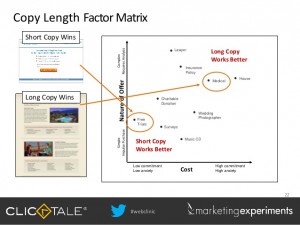
You may have seen our reviews of ME’s interesting webinars – see our past one on images vs. copy, and another on copywriting under tight deadlines. While I tend to focus on the copywriting webinars, the good folks at ME have a wealth of knowledge backed by exceptional, thorough testing. And I’m sure you’ll agree that Dr. McGlaughlin’s presentations are always engaging and especially insightful.
With that said, I wanted to share the latest webinar I was able to catch – the main reason being it was probably the most interesting one for me thus far.
Without further ado, continue reading for more about how to strike the right balance in your landing pages. And when you have an extra hour, we most definitely recommend you check out the webinar (embed below).
Long copy vs. Short Copy – Which Should I Choose?
It’s a common dilemma copywriter’s face, and a controversial topic to boot. Some say long is better, while others say short. As marketers and copywriters, we often fret over which is better for a landing page – a longer page, or a shorter one?
But as Dr. McGlaughlin explains, this is not the real question, and doesn’t address the points you need to consider when deciding between the two for your landing page.
In their first example, ME looks at a page offering free psychological evaluations. The control was pretty long, and the 3 test pages were shorter. What they set out to determine was which page would produce the highest conversion using A/B split testing/comparison.
They found that as the page got shorter, the conversion rate increased. The control’s conversion rate was 16.52%, while T1’s was 19.95%, T2’s 23.14% and T3’s 25.4%. So in effect, as the page length decreased, the conversion rate increased.
If you were to take this example alone, it would be easy to assume that short pages perform better. But short copy doesn’t always yield higher conversions.
Let’s take their other example to make this point…
The next landing page Dr. McGlaughlin looked at was for a treatment center for addiction. Needless to say, this type of “offer” is one tough nut to crack. In this example, the longer page performed over 220% better than the shorter one (control).
Now you’ve just confused me – how did the first case have better conversions with a shorter page, and the second have better conversions with a longer one?
This is where the webinar gets really interesting. As marketers, a big part of our job involves trying to understand the psychology of the customer. The business will have a general idea, but it’s the job of marketers to bridge the gap between what the company knows, and what the customer is actually thinking.
In understanding the fears, desires and needs of our customers, we can then get an idea of the series of conclusions a visitor will need to go through before they’re ready to purchase or subscribe.
This brings us to the first of several key principles – one effective way to increase conversions is to decrease “friction,” or psychological resistance to your offer. Copy length is one type of friction, and one of the easiest to address.
However, short copy doesn’t always perform better as we see in the treatment center example. You need enough “micro” yes responses to build up to the big yes, which in their example was the visitor requesting a free evaluation.
To effectively determine these elements for your specific offer, go beyond the surface elements of bullet lists, banners and sub-headings, and try and determine the cognitive conclusion that you want to occur. In the treatment center example, some common questions include: Is it safe? What are the risks in giving my name?
Rather than asking how you can make an exceptional page, ask why. Try and understand the motivations and general psychology of your target audience and build from there.
Another key principle to keep in mind – friction doesn’t exist on a page, it exists in the mind of your customer.
In other words, you need to do what you can to decrease mental effort, not the length of your page. If longer copy is required to address psychological resistance, then by all means include it.
Dr. McGlaughlin reminds us of some sage advice from author Ernest Hemingway – “make every word tell.”
In other words, make sure every word and sentence contributes to the overall offer and reducing friction.
Here’s a wonderful copy length factor matrix that ME put together to help you try and visualize the best copy length for a particular type of offer – it’s based on cost and the nature of your offer. As we can see, the higher commitment, higher cost offers require more copy to decrease friction on the mind of your customer.
If your offer doesn’t cost much and is simple, you can get away with shorter copy.
(NOTE: AS THE WEBINAR EMPHASIZES, CHARTS LIKE THIS ARE FOR REFERENCE ONLY. DON’T RELY ON THIS CHART, BUT RATHER WORK TO BETTER UNDERSTAND THE PSYCHOLOGY OF YOUR AUDIENCE)
This brings us to the final key principle Dr. McGlaughlin and ME wanted to impart – copy is often times required to guide the visitor’s thought sequence. Don’t put blinders on and assume that short copy always does better. In the end, it depends on your offer. If it’s more complex and costs a lot of money, it’s likely that you’ll need more copy to allay visitor concerns.
Wrapping up, the question of whether short or long copy is better isn’t easy to answer – it all depends on your offer and what your customers are thinking. Toward the end of the main webinar at 21:10, ME has a checklist you can follow.
Dr. McGlaughlin provides probably the best statement on landing pages I’ve heard – “optimization doesn’t occur on a page, it occurs in the mind.”
In the end, be customer-centric, not company-centric. As you may have read here before, don’t pump yourself up, but rather relate to your customer by using “you,” “your” and those type of phrases – nobody wants to hear you gloat about yourself.
And never ask someone to do something they can’t fully conceptualize – according to ME and other research, this is considered by many to be the biggest reason why someone clicks off a page.
We strongly urge you to spend some time watching the webinar – this summary is just a brief overview of the concepts Dr. McGlaughlin discusses. Their extensive research is very helpful in visualizing how you should approach landing pages.
Join the conversation!!
What are your thoughts on the webinar, and ME’s research on the ideal length of a landing page?
Feel free to leave us a comment below, or drop us a line on our Facebook, Twitter, or Google+ profile today.

